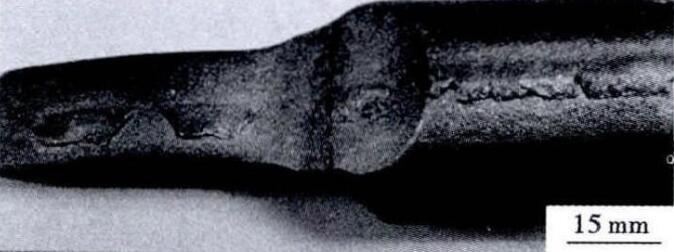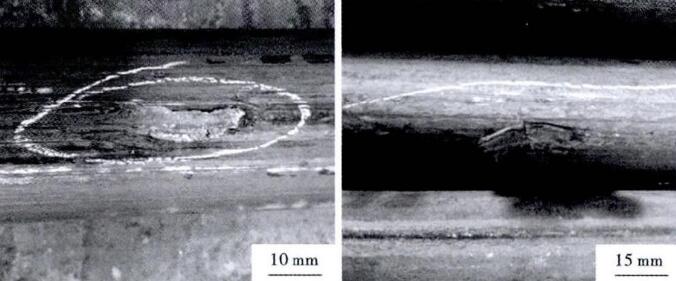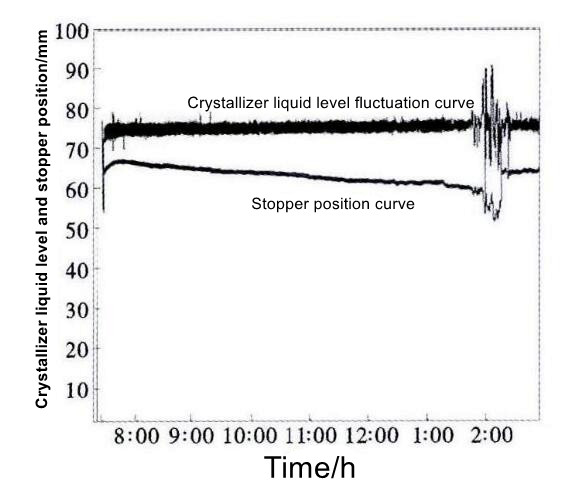The production process of 20Cr steel is 120t billet CC rolls BOF-LF-200mm×200mm. Composition tests, metallographic analysis and scanning energy spectrum analysis by electron microscopy were carried out on the scars and deformations of small mechanical crankshafts forged from Φ35mm 20Cr round steel.
The results show that the fluctuation of the liquid level in the crystallizer during continuous casting is greater than ±5 mm, which causes the protective slag to penetrate the curved lunar surface, resulting in slag inclusions on the billet surface and carbonization and scarring formation – and deformation errors in the rolling process.
By increasing the immersion depth of the water port from 80-120mm to 90-130mm, the water port control of the middle pack and plug rod is strengthened, and the slag protection operation and thickness performance of the slag layer are optimized from 10 -15mm to ensure that crystallizer liquid level fluctuations stabilize within ±3mm and thus prevent the formation of billet slag and distorted forging skin.
20Cr steel is used in a wide range of mechanical engineering applications. Steel mills use 20Cr round steel with a specification of Φ35mm and produce forged crankshafts for small machines.
When forging round steel sections, it was discovered that some forgings had defects in the surface grain layer and could not be produced further. In this case, sites are examined and samples are taken, composition is checked, metallographic analysis and scanning electron microscopy spectroscopy are analyzed, and the production process is tracked to analyze the causes of defects.
1. 20Cr Steel Forged Crankshaft Manufacturing process
20Cr round steel production process for 120t BOF-120t LF-CC (section 200mm × 200mm) – bar rolling. 20Cr steel small crankshaft processing process for round steel → shearing → medium frequency heating → forging → billet parts → rough turning.
2. Macroscopic morphology of defective forgings
To better observe the defective morphology, the defective forgings are shot peened to remove the iron oxide treatment in Figure 1. The macroscopic morphology of the scar and skin defects as well as the location, size and depth vary in the form of a band or tongue adhered to the round steel substrate.
One end of the forging has been freely forged, and the other end of the round steel surface has warped coating defects at both ends. Therefore, the judgment is not caused by deformed skin during forging.
So I picked up 20Cr round bars one by one for this furnace and found that some round bars also had scar skin defects (see Figure 2). The defects are irregularly arranged and distributed across the head, middle and end of the round steel. The size and depth vary, and deformation defects occur during crankshaft forging.
3. Analysis of the causes of errors
3.1 Analysis of chemical composition
The chemical composition detected by the spectrometer and the melt composition are subjected to comparative analysis, see Table 1. The results show that the chemical composition meets the chemical composition requirements of 20Cr steel in accordance with GB/T 3077-2015, and the composition of the melt is also consistent. 
Figure.1 Appearance of defective forgings 
Figure 2: Morphology of corrosion and deformation defects in Φ35mm 20Cr round steel
Table 1 Chemical composition of 20Cr/% steel
| Project | W | Yes | Mn | Cr | P | s |
| Standard requirements | 0.18-0.24 | 0.17-0.37 | 0.50- 0.80 | 0.70-1.00 | ≤0.030 | ≤0.030 |
| Melted composition | 0.21 | 0.23 | 0.62 | 0.84 | 0.016 | 0.006 |
| Defective forged parts | 0.21 | 0.22 | 0.61 | 0.84 | 0.014 | 0.0077 |

Fig. 3 Microscopic morphology of deformation defects in 20Cr steel
3.2 Metallographic analysis
Metallographic samples were collected along the longitudinal direction of the deformation layer of 20Cr steel defects and their microscopic morphology was examined with an optical microscope. After grinding, the samples were polished and etched with 4% nitric alcohol solution.
Microscopic metallographic photographs are shown in Fig. The deformation layer extends into the substrate and forms cracks that form an acute angle to the surface of the round steel. The cracks are bifurcated and there are obvious decarburization and dense high-temperature oxide stains.
Medium frequency heating is used in forging. The heating time is short and not enough to produce such strong decarburization and high temperature oxides. It only occurs when rolled steel is heated before production. Therefore, defects in the rolling furnace are evaluated before the billet.
The metallographic organization shown in Figure 3 shows that the organization of nearby defects is different from the normal organization of 20Cr mild steel, and the pearlite increases significantly.
Therefore, deformed skin was found in the forged skin. Metallographic samples were also collected in several longitudinal positions. When observing the organization, see Figure 4, the pearlite phenomenon also seemed to increase, proving that the occurrence of carbon near the deformed skin increases.
3.3 Spectral analysis by electron microscopy
Figure 3: Defects in electron microscope scanning, major cracks and bifurcation defects are found to protect the protective slag composition F, Na. The electron microscope spectroscopy analysis shows in Table 2 the composition of F: 5.88%, Na: 3.69%. Table 2 in percentage by mass of the element converted into oxide composition in Table 3, compared with the composition of the crystallizer protective slag, whose main components are C, F, Na 2 O, CaO, SiO 2 Al 2 Ó 3 and the protective slag composition is consistent; Therefore, billet defects in the continuous casting process are caused by the involvement of the crystallizer's protective slag.
3.4 Analysis and measurements for continuous casting slag rolls
3.4.1 Analysis of the causes of slag rolling
Slag defects on the surface of cast billets are caused by four factors: fluid level fluctuations in the crystallizer caused by slag rolling; bending impact of the moon's surface caused by slag; physical parameters of the protective slag and vibration of the crystallizer. Liquid level fluctuations in the crystallizer increase the risk of slag lamination in the crystallizer steel, which is the direct cause of slag defects in the billet.
To determine the cause of slag formation, the continuous casting process of this furnace was examined. Liquid level fluctuations in the crystallizer were found to be abnormal (see Figure 5). Typically, liquid levels do not fluctuate more than ±3 mm, but 6 streams show abnormal fluctuations of more than ±5 mm, the largest more than ±10 mm. According to the plug position curve, the plug sinks continuously from the beginning, indicating that plug erosion occurs faster than the direct cause of fluid level fluctuations.
Research has shown that: when fluid level fluctuations are ±5mm, the depth of subcutaneous slag is less than 2mm, this slag can be eliminated by heating the billet in the furnace; If the fluid level fluctuates ± 10 mm and the depth of the subcutaneous scum is less than 4 mm, surface cleaning should be carried out. 
Figure 4: Deformed outer skin of 20Cr steel in the morphology of increasing carbon organization (a), transitional organization (b) and normal organization (c).
Table 2 Energy spectrum analysis of deformation defects in 20Cr/% steel
| W | O | F | N/A | mg | Al | Yes | K | About | Mn | Faith |
| 15.97 | 37.6 | 5.88 | 3.69 | 0.8 9 | 2.69 | 14.98 | 1.11 | 8.72 | 6.33 | 1.3 |
Table 3 Comparison of protective slag compositions and distortion inclusions/%
| category | N A 2 Oh | MgO | Al 2 Ó 3 | SiO2 | Dog | F | W |
| protective scum | 7.33 | 3.9 4 | 4.22 | 35.27 | 27.2 | 6.49 | 12:45 |
| Recording | 7.93 | 1.48 | 5.08 | 32.73 | 30.5 | 5.88 | 15.97 |

Fig. 5 Liquid level fluctuation curve in the crystallizer in furnaces with distortion problems
3.4.2 Analysis of the causes of carbon increase
A clear charring phenomenon occurs close to the wrinkled skin defect. The carbon increase mainly comes from the carbon in the protective slag, which acts as a barrier layer and skeleton to regulate the melting rate and obtain a satisfactory structure of the slag layer, which is a longitudinal layered structure of the original slag layer, the sintering layer and the molten slag layer from top to bottom.
The solubility of carbon in the slag layer is very low, 0.1% to 0.4%; Between the slag layer and the sintering layer there is a layer enriched with carbon, whose carbon concentration is 1.5 to 5 times greater than that of the original slag, which is the main reason for the increase in carbon in molten steel. When the liquid level fluctuates greatly, the thickness of the slag layer is insufficient, so the carbon-rich layer interferes with the crystallizer and the billet shell, resulting in an increase in carbon in the billet.
3.4.3 Control measures
- (1) Corresponding increase in the insertion depth of the submerged water outlet. Reduce the insertion depth from 80-120mm to 90-130mm and reduce the crystallizer liquid level fluctuation to ensure liquid level stability.
- (2) Check the water outlet and insert the middle pack wand. Each batch goes through quality control at the factory to avoid moisture and before transportation and installation to avoid shocks. Before use, make sure the baking effect and baking temperature are above 1100°C or more to form a dense protective layer that reduces surface decarburization of loose parts.
- (3) Optimize the operation and performance of protective slag. The continuous casting process and strict implementation of the protective slag are carefully added, added less, and the standardized operation is supplemented to ensure that the black surface operation simultaneously optimizes the physical and chemical properties of the protective slag to ensure adequate viscosity and mobility and a sufficient slag layer thickness of 10-15 mm is achieved.
By implementing control measures, the crystallizer liquid level fluctuation is stabilized within ± 3 mm. By checking the casting surface of 20Cr steel ingot and arranging it at low times, it has been improved so that there are no similar slag defects in the cast ingot and no deformed skin in the forgings.
4. Conclusion
- (1) 20Cr steel Crankshaft forging Distortion defects in crystallizer slag undercarriage caused by defects in casting slag billets.
- (2) Abnormal fluctuation of the crystallizer liquid level by more than ±5mm is the main cause of slag formation in the ingot. When the fluctuation of the crystallizer liquid level is stabilized within a range of ±3mm, the slag rolled into the ingot is controlled, thus eliminating the inclusion defects in the ingot.

























































